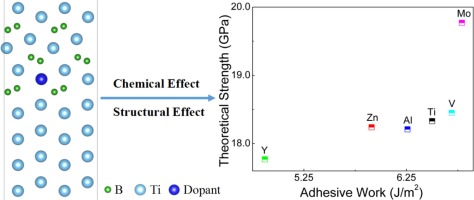当前位置:
X-MOL 学术
›
Comp. Mater. Sci.
›
论文详情
Our official English website, www.x-mol.net, welcomes your
feedback! (Note: you will need to create a separate account there.)
Regulation of the interface binding and mechanical properties of TiB/Ti via doping-induced chemical and structural effects
Computational Materials Science ( IF 3.1 ) Pub Date : 2020-03-01 , DOI: 10.1016/j.commatsci.2019.109506 Tingbo Zhang , Naiqin Zhao , Chunsheng Shi , Chunnian He , Enzuo Liu
Computational Materials Science ( IF 3.1 ) Pub Date : 2020-03-01 , DOI: 10.1016/j.commatsci.2019.109506 Tingbo Zhang , Naiqin Zhao , Chunsheng Shi , Chunnian He , Enzuo Liu

|
Abstract In order to enhance the mechanical properties of TiB/Ti composites through interface modulation, in this study, the interface binding and mechanical properties of clean, Zn, Y, Al, V and Mo doped TiB (1 0 0)/Ti 10 1 ¯ 0 interfaces are studied by first-principles calculations. The most stable clean interface, B23 system, is selected as the doped initial model due to the largest adhesive work and the lowest interface energy. It is found that the doping effects on the interface binding and theoretical strength consist of chemical effect and structural effect. Zn, V and Mo doping have chemical effect, which provide vacancy or excess electrons to reduce or increase interface binding and theoretical strength. However, Y and Al doping cause the lattice distortion and weaken the interface binding and theoretical strength. In addition, V and Mo can also prevent crack propagation inside TiB through increasing the elastic modulus. This is helpful to understand the relationship between interface binding and mechanical properties, and provides new ideas for the design of high-strength TiB/Ti composite.
中文翻译:

通过掺杂诱导的化学和结构效应调节 TiB/Ti 的界面结合和机械性能
摘要 为了通过界面调制提高 TiB/Ti 复合材料的力学性能,本研究对清洁、Zn、Y、Al、V 和 Mo 掺杂的 TiB (1 0 0)/Ti 10 1 的界面结合和力学性能进行了研究。 ¯ 0 界面通过第一性原理计算进行研究。由于最大的粘附功和最低的界面能量,最稳定的清洁界面 B23 系统被选为掺杂的初始模型。发现掺杂对界面结合和理论强度的影响包括化学效应和结构效应。Zn、V 和 Mo 掺杂具有化学作用,可提供空位或过剩电子以减少或增加界面结合力和理论强度。然而,Y和Al掺杂导致晶格畸变并削弱界面结合和理论强度。此外,V 和 Mo 还可以通过增加弹性模量来防止 TiB 内部的裂纹扩展。这有助于理解界面结合与力学性能的关系,为高强度TiB/Ti复合材料的设计提供新思路。
更新日期:2020-03-01
中文翻译:

通过掺杂诱导的化学和结构效应调节 TiB/Ti 的界面结合和机械性能
摘要 为了通过界面调制提高 TiB/Ti 复合材料的力学性能,本研究对清洁、Zn、Y、Al、V 和 Mo 掺杂的 TiB (1 0 0)/Ti 10 1 的界面结合和力学性能进行了研究。 ¯ 0 界面通过第一性原理计算进行研究。由于最大的粘附功和最低的界面能量,最稳定的清洁界面 B23 系统被选为掺杂的初始模型。发现掺杂对界面结合和理论强度的影响包括化学效应和结构效应。Zn、V 和 Mo 掺杂具有化学作用,可提供空位或过剩电子以减少或增加界面结合力和理论强度。然而,Y和Al掺杂导致晶格畸变并削弱界面结合和理论强度。此外,V 和 Mo 还可以通过增加弹性模量来防止 TiB 内部的裂纹扩展。这有助于理解界面结合与力学性能的关系,为高强度TiB/Ti复合材料的设计提供新思路。











































 京公网安备 11010802027423号
京公网安备 11010802027423号